
Brand Management – Brand management can only be effective if and only if you can connect with your customers on familiar business platforms. The goal of this strategy is to increase customer engagement and engagement with your business, help change perceptions, predict product expectations, and improve relationships with your “gods.” .
Obviously, the essence of brand management is to build a bridge connecting the relationship between the brand and the target audience. A good brand management strategy will help optimize the effectiveness of communication, Marketing, PR, and activities on social networking platforms. Thereby, you can completely tweak and transform your core product/service to give your customers the best user experience.
With what brand management can bring, we cannot deny their importance to communication and promotion of products / services. Especially in the context of industrial revolution 4.0. is reaching its peak, where your every impact in the digital environment can be surprisingly beneficial and effective.

Here are 11 principles to help you succeed in Brand Management strategy – brand management.
>>> 19 Brand promotion strategy
But first, learn about:
Brand Management – What is Brand Management?
Brand management is the process of improving customer and public perception of a brand. To do this, businesses need to focus on developing awareness , identity , brand equity, as well as customer loyalty to the brand.
There is a difference between branding and brand management :
Branding is the process by which a business builds and develops a brand from scratch. While brand management is the latter part of the problem: How a business maintains and develops a brand’s reputation, through its activities. Monitor and modify as needed.
In a rapidly evolving society, your brand also needs to change and adapt to new trends and new spins. If the brand is considered as a story, then brand management is a form of controlling and coordinating it, in order to create new, more attractive, more timely versions.
>>> Brand Story – A Guide to Telling an Attractive, Captivating Brand Story
Brand management seems simple, but extremely difficult, if you are at a crossroads with no direction. Without making you wait long, here are 11 basic brand management principles that will hopefully help you point yourself in the right direction:
#first. Define your brand
Let’s start with the very core of a brand – its uniqueness, its goals, its vision, its standing, its ethos and values. Focus on the best aspects of your brand, which help you convey what is quintessential and beautiful in the product/service you offer.
There are dozens of typical cases where rich companies are willing to spend millions to buy “little fish”, and then have to quickly sell them off to cut their losses.

Microsoft once acquired Razorfish – a rising star in the digital marketing field, but because of the disagreement between the goals and strategic visions between the two sides, Microsoft had to quickly release the swordfish for $ 530 million, only equal 10% of the amount Windows owners had to spend in 2007.
#2. Your brand is a reflection of your business model
Support and challenge your business to maximize the huge potential benefits your brand can bring. Think about top personal brands like Barack Obama or Richard Branson (the owner of Virgin Group). Nearly all of these outstanding individuals have built their career fortunes based on their own charisma.

Maybe the corporate brand is just an extension of their personal brand. So that. Your brand should be a reflection of what your business is.
#3. Uniformity, uniformity, and again, uniformity
Consistency in the messages conveyed to customers (with the core values of the business) is always the key to help you differentiate and stand out from the crowd.

Consider the following examples: Obama in his historic 2008 US Presidential campaign speech always emphasized one (and only 1) single message: Change .
The monster in the car industry, despite infinite variations and creativity in advertising campaigns, always directs viewers to a core principle: “The Ultimate Driving Machine ” – Dark car machine upper.
>>> Brand Extension: What is Brand Extension Strategy?
#4. Multi-dimensional consultation
The hard-working and diligent employees in the business can completely become effective assistants, speaking most boldly and honestly about their feelings about the brand. This can give you unbelievable results.
That’s exactly what the online fashion retailer Zappos has done to change customers’ perception of the brand. So remember carefully: Consult many dimensions (maybe from skilled employees in the business) about the brand, before launching them into the market.
#5. Connecting to the “emotional” space
A brand is not just a logo design , a strange name, a Web page, a few advertisements or a mere PR campaign. It is something bigger, a product/service idea that can touch the emotions and thoughts of the shopper.

Take, for example, the Starbucks chain of coffee shops. Starbucks gives customers a great experience, a great space to enjoy coffee and chat with friends, a unique taste that is hard to be compared with other places, a place to go back, where customers often visit. , despite the fact that they have to pay for higher priced coffee cups than other brands.
The advice given here when you build a brand is: not only pay attention to the tangible aspect of the brand, the emotional aspect of the customer is also an important factor determining their satisfaction when experiencing. products/services.
>>> Why do brands need to position themselves according to customers?
#6. Brand is not just the story of a business
What makes big brands like Apple able to spread their influence around the world? Let’s do a little test:
You try to visit and talk to an Apple fan, who often lines up to be the first to hold, own each new iPhone line on sale.
Maybe a whole day can’t describe the excitement, their burning and intense passion for the products of the apple house. Every time an Apple product launches, it’s really like a festival for Apple followers.

So, what is the crux of the matter here? Businesses need to build themselves a community, which includes people who love and adore your brand. Let them convey your brand message in the most natural way, like Apple did with their fans.
>>> 10 Product Pricing Strategies In Marketing
#7. Be as flexible as drops of water, but make sure they align with core values
Good brands are always ready to adapt to any change. But you should remember: Branding is a process, not a race. The core of the problem is that you have to be as flexible as the drops of water, but don’t forget to align them with the core principles of the business.
A great brand manager never uses marketing tricks simply because it has worked in the past. The world changes from minute to minute, could the marketplace out there stand still?
Therefore, businesses need to show how innovative and responsive they are to the changes of the times. But also don’t forget to reference them to the values that make up the brand’s name.
>>> 3C principles for better creativity
#8. Align specific tactics with the overall strategy
Communicate your brand message on the most appropriate media platforms using specific objectives. Every day, consumers overwhelm themselves with dozens of innocuous advertisements. It is so much that it becomes counterproductive and makes people uncomfortable.
Many customers actively block ads on the internet or switch TV channels. Invest your branding efforts on the right media to communicate it to the right target audience.

While TV advertising can be expensive, it also has wide coverage and can deliver instant results. On the other hand, social media is much cheaper, but customers have a longer time to “ingest” the message conveyed. The efforts of your business may not bring the results you want.
So, be flexible in aligning specific marketing tactics every time you notice something amiss. But remember the previous lesson: Align change with the overarching strategy originally laid out.
>>> 7 Principles of business strategy in modern times
#9. Measure effectiveness
Focus on return on investment ( ROI ), which is a key metric to measure the effectiveness of your brand management strategies. It often depends on how well your brand is spread after implementing the overall branding strategies.
The performance of the metric also accurately reflects your brand value, i.e. how customers react to quantity and price adjustments of products/services. Adjusting the value of the brand must lead to an increase in sales and profits. But make sure you don’t just focus on increasing sales, as you can achieve better profit margins by cutting costs in general.
There are many different ways to test and measure the effectiveness of a marketing campaign / tactic besides ROI, but remember, what you do must be closely linked to the original strategy and value. the core of the brand.
#ten. Keep your opponent close to you
Even if you have one of the most coveted brands in the world, you must always be ready for new competitors with more shocking prices that have just entered the market. A market, for any product or service, is never small enough to discourage new players from entering and creating competition.

You are always facing another competitor that offers a faster, better service/product and more importantly, they are cheaper. Call them competitive economies, challenge pricing or whatever, but more importantly, it helps you develop new, more effective, and more innovative strategies.
And you may not believe it, but it really adds value to your brand.
#11. Have broad visionary
IDEO CEO Tim Brown calls design thinking a process for creating new choices. Basically, it’s not only about the alternatives, but also thinking outside the available framework.
This concept, basically, applies to the process of creating a brand strategy that experts often call the brand strategy thinking. It’s easier to come up with specific tactics, rather than introduce a new overarching strategy because that could imply a big chance of failure.
Plus, it makes it easier to copy your competitors’ successes, instead of having to start with something completely new.

#12: Customer Engagement
The customer, broadly speaking, a community, is the most powerful player in a commercial relationship. They are the people businesses need to connect with, and can also build a community of loyal customers with the brand – a new kind of “religion”.

To win the hearts of customers, you need to connect them with your brand. An interesting way that many large businesses apply today is to allow customers to participate in the process of building and managing the brand. Customers are asked about packaging, product design, the price they want, etc.
If they are involved in the process of building a brand, customers will tend to be more engaged and loyal to them.
>>> What is Brand Loyalty? Building Brand Loyalty
summary
Brand Management – Brand management is the bridge connecting customers with the brand. You need to accurately convey the value of the brand with the actual experiences that customers can get when using the product / service. You shouldn’t just copy your competitors’ successes, but stick to and tailor them to your business’s core values.
Therefore, what you need to do when building a brand strategy is to consult with stakeholders in the business (such as partners, employees, ..) to build a relevant strategy. closely associated with the core values of the brand, in order to bring the best service / product experience to customers. The results will definitely make you feel satisfied and satisfied.
>>> Learn about Philip Kotler’s Brand Strategy theory
Refer to Malu ‘s premium brand identity design service .




